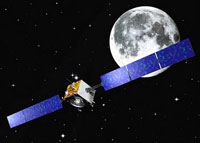歐“智能1號(hào)”飛船成功撞月
[ 2006-09-04 14:26 ]
|
 |
Europe's first spacecraft to the
moon ended its three-year mission Sunday by crashing into the lunar surface
in a volcanic plane called the Lake of Excellence, to
a round of applause in the mission control room in Germany.[AP]
|
Europe's first
spacecraft to the moon ended its three-year mission Sunday by crashing
into the lunar surface in a volcanic plain called the Lake of Excellence,
to a round of applause in the mission control room in Germany.
Hitting at 2 kilometers per second, the impact of the SMART-1
spacecraft was expected to leave a 3-meter-by-10-meter crater and send
dust kilometers above the surface.
Observatories watched the
event from Earth and scientists hoped the cloud of dust and debris would
provide clues to the geological composition of the site.
"That's it -- we are in the Lake of Excellence," said spacecraft
operations chief Octavio Camino as applause broke out in mission control
in Darmstadt, Germany. "We have landed."
Minutes later, officials showed off a picture captured by an
observatory in Hawaii displaying a bright flash from the impact.
Launched into Earth's orbit by an Ariane-5 booster rocket from Kourou,
French Guiana, in September 2003, SMART-1 used its ion engine to slowly
raise its orbit over 14 months until the moon's gravity grabbed it.
The engine, which uses electricity from the craft's solar panels to
produce a stream of charged particles called ions, generates only small
amounts of thrust but only needed 80 kilograms of xenon fuel.
The craft's X-ray and infrared spectrometers have gathered information
about the moon's geology that scientists hope will advance their knowledge
about how the moon's surface evolved and test theories about how the moon
came into being.
The spacecraft has also been taking high-resolution pictures of the surface with
a miniaturized camera.
(Agencies)
|
周日,歐洲首架探月航空器結(jié)束了三年探月之旅,成功擊中月球表面的“卓越湖”火山平原,此消息讓德國(guó)的地面控制大廳里爆發(fā)出熱烈的掌聲。
這架名為"智能1號(hào)"的探測(cè)飛船的撞月速度為每秒2公里。按照此速度,這次撞擊預(yù)計(jì)會(huì)在月球表面留下一個(gè)直徑3米,深10米的坑,而且會(huì)在月面激起幾公里高的塵埃。
很多觀測(cè)站在地表觀測(cè)了撞擊全過程,科學(xué)家希望撞擊所激起的塵云和碎石能為研究“卓越湖”區(qū)域的地質(zhì)構(gòu)成提供依據(jù)。
位于德國(guó)達(dá)姆施塔特的控制中心爆發(fā)出熱烈掌聲,探測(cè)器地面指揮所負(fù)責(zé)人奧克塔唯奧·卡米諾說:“成功了!我們撞上了卓越湖區(qū)!我們著陸了!”
幾分鐘過后,地面指揮所的官員公布了一張位于夏威夷的某觀測(cè)站拍攝到的“撞擊亮光”照片。
2003年9月,“智能1號(hào)”探測(cè)器從法國(guó)圭亞那地區(qū)的庫魯基地由Ariane五號(hào)火箭發(fā)射升空,在其離子引擎的推進(jìn)下,“智能1號(hào)”緩慢脫離運(yùn)行軌道,在14個(gè)月后進(jìn)入月球重力場(chǎng)。
離子引擎將航天器太陽能面板所采集的太陽能轉(zhuǎn)化為電能,再生成帶電的離子流。太陽能離子引擎所產(chǎn)生的推動(dòng)力并不大,但所需要的氙氣燃料也很少,只有80千克。
“智能1號(hào)”的X光和紅外線分光儀采集了關(guān)于月球地質(zhì)的很多信息,科學(xué)家們希望這些信息能夠豐富他們有關(guān)月面進(jìn)化的知識(shí),并能為檢驗(yàn)月球形成的各種理論提供依據(jù)。
“智能1號(hào)”上還裝有一個(gè)微型照相機(jī),它拍攝了很多高清晰的月面照片。
(英語點(diǎn)津姍姍編輯)
|
|
|
Vocabulary:
|
|
obervatory: 觀測(cè)站;天文臺(tái)
high-resolution
picture: 高清晰照片
|
|
|
|